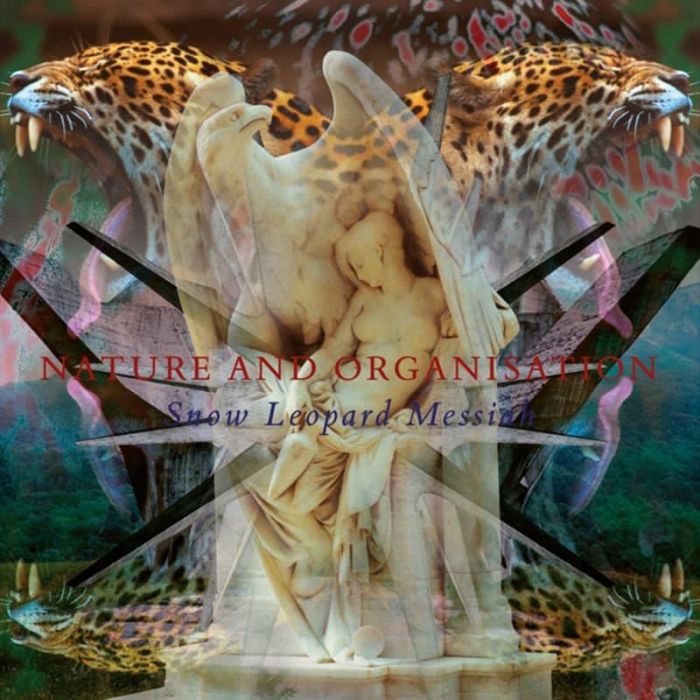Snow Leopard Messiah by Nature and Organisation (Review)

If you do any research into neofolk or apocalyptic folk music, you’ll soon see several names pop up repeatedly, specifically David Tibet, Douglas P., and Tony Wakeford (the minds behind Current 93, Death in June, and Sol Invictus, respectively). Other names, like Steven Stapleton (Nurse with Wound), Ian Read (Fire + Ice), Michael Moynihan (Blood Axis), Rose McDowall, and B’ee (In Gowan Ring) may also figure prominently in your results. However, I’d argue that one of the genre’s most important individuals will probably (sadly) go largely unmentioned, and that would be Michael Cashmore.
While that may be due to his self-effacing nature (as revealed in this interview), the fact remains that Cashmore has been responsible for a significant amount of the music for Current 93 (arguably the neofolk outfit) since at least 1991’s As The World Disappears…. His guitar work and arrangements can be heard throughout albums like Of Ruine or Some Blazing Starre and Soft Black Stars. In addition to his work with Current 93, Cashmore has also released two highly regarded recordings under his own name, both of which eschewed neofolk’s harsher elements and instead, focused on graceful, melancholy guitar compositions.
Two decades ago, however, Cashmore produced several releases under the Nature and Organisation moniker, releases that have been long out of print… until now. Thankfully, the folks at Trisol have released Snow Leopard Messiah, a nigh-comprehensive two-disc compilation featuring remastered versions of those decades-old Nature and Organisation releases. I doubt Snow Leopard Messiah will make Cashmore a household name — neofolk isn’t exactly the most accessible of genres — but hopefully it will bring him more of the regard and renown that he deserves.
Disc one contains everything from 1994’s Beauty Reaps the Blood of Solitude and A Dozen Summers Against the World, and these songs — along with The Revolutionary Army of the Infant Jesus — represent the apotheosis of neofolk to these ears. The disc’s thirteen songs blend Cashmore’s skilled compositions with plenty of industrial scrapings and grindings, loops, drones, and odd samples as well as various vocalists (Rose McDowall, David Tibet, Douglas P., Steven Mason). They range from haunting, melodious, and ethereal (“Wicker Man Song,” “Blood of Solitude I,” “Tears for an Eastern Girl”) to harsh and overwhelming (“Beauty Destroyed”) — and sometimes somewhere in-between (“Obsession Flowers and Torture,” “A Dozen Winters of Loneliness”).
Even during the album’s strangest moments, Cashmore’s skill as a composer and arranger is hardly obscured. It’s tempting to fixate on David Tibet’s unique sing-song delivery on a song like “Tears for an Eastern Girl,” especially with lyrics like these:
Lost you are to me though in you I had hope to lie
Your teeth are mirroring the tiny stars
Smoky, you flood by me
Ripples of jasmine
Heavy smoke in your path
Wait for me by the summer stream
But move just beyond Tibet’s inimitable performance and you’ll hear lush, lovely arrangements of swirling woodwinds, strings, and graceful guitar filigrees. Later, on “Skeletontonguedworld,” more flutes and violins weave together in a most beguiling manner even as Tibet speaks of a “black sightless fire-pierced black universe” and a “long-tongued god” dragging chains in “his wicker-fingered hands.”
Disc two contains 1998’s Death in a Snow Leopard Winter, which was originally released in an unfinished form. Cashmore had planned to add vocals and other instrumentation to the twelve tracks — and they remain in their unfinished form on Snow Leopard Messiah. But even unfinished they’re lovely in their own right. The dozen tracks are purely instrumental, consisting of Cashmore on piano joined by a string quartet. The gentle melancholy that undergirds songs like “Death in a Snow Leopard Winter, Pt. 1” and “Death in a Snow Leopard Winter, Pt. 3” clearly presages Cashmore’s more recent solo outings, and any “modern classical” fan or fan of lush piano music should find them enjoyable and interesting.
That being said, there is a certain uniformity and same-ness to the second disc that eventually causes all of the tracks to blur together. I can’t help but wonder what might’ve been had Cashmore been able to follow his original plans and add more elements à la Beauty Reaps the Blood of Solitude. That earlier album did such a fine job of balancing the graceful and beautiful with the harsh and ominous, and I hear the seeds of more of that in Death in a Snow Leopard Winter’s sketches. One only wonders what cryptic images David Tibet would’ve paired with the graceful swells and riverine movement of “Death in a Snow Leopard Winter, Pt. 5,” for instance.
Ultimately, Snow Leopard Messiah reveals that Cashmore’s greatest contribution to neofolk is how supremely listenable and pleasant he makes it. Such a comment may seem disparaging or backhanded at first, but that assumes being cryptic, obtuse, and otherwise standoff-ish is somehow the artistic ideal. However, accessibility is, in itself, not a bad thing. Rather, it can make for gorgeous music and a supremely enjoyable and affecting experience — which Snow Leopard Messiah offers time and again.